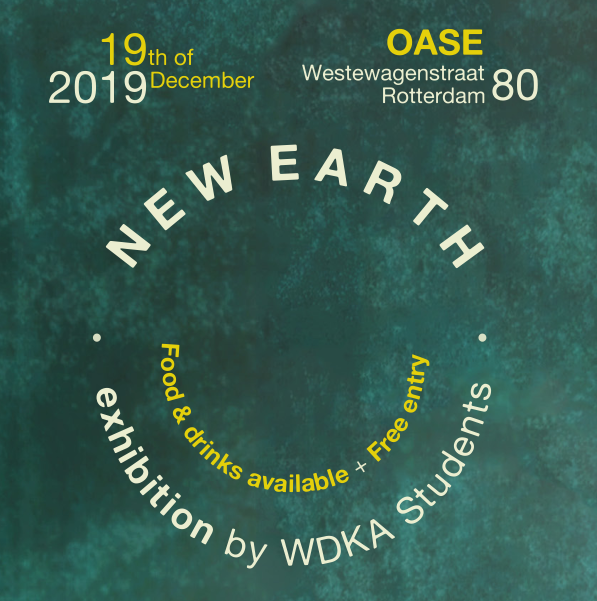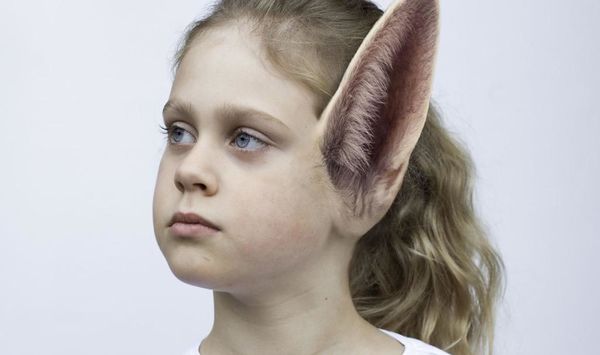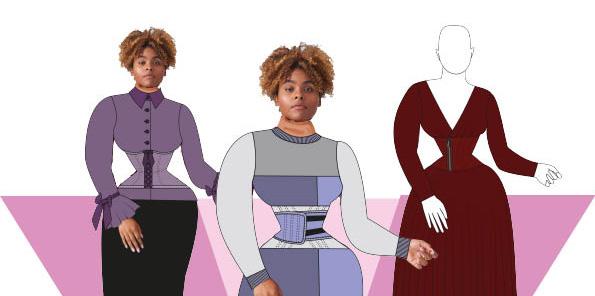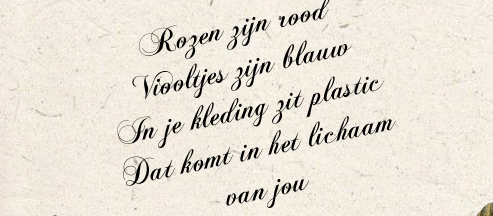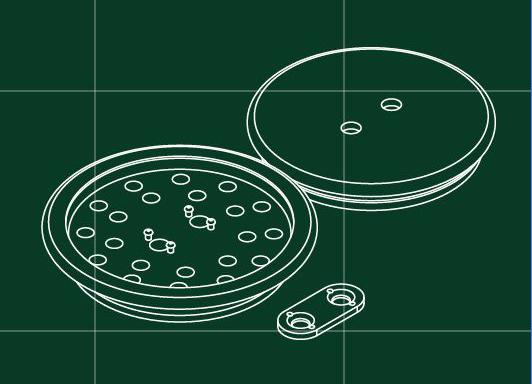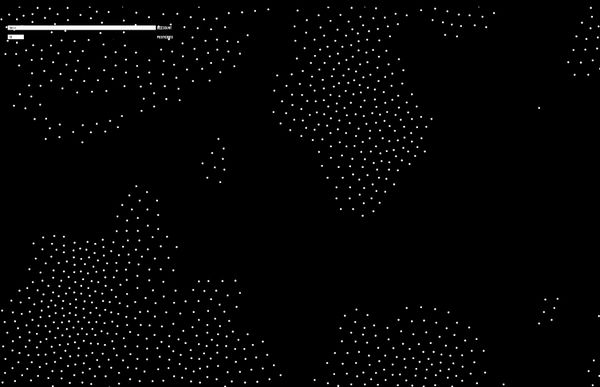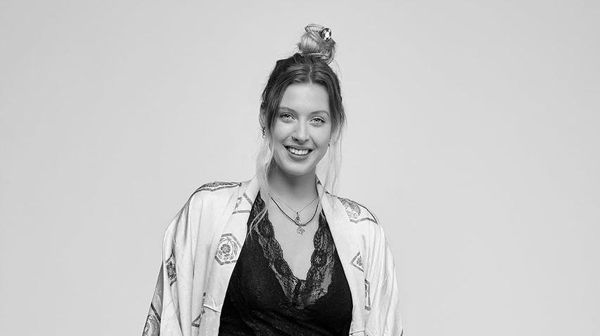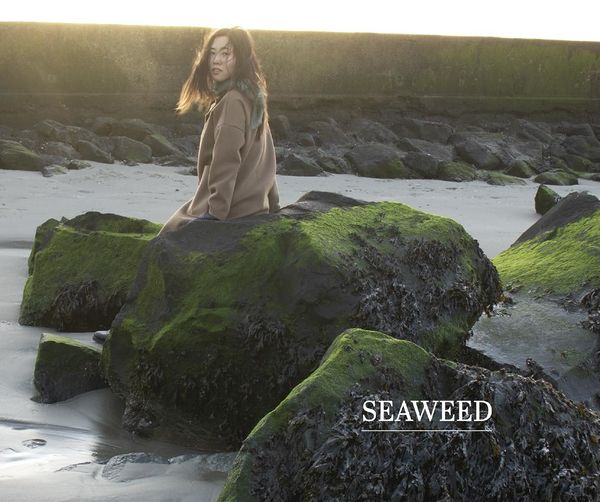New Earth Exhibition, Dec 2019
Contents
- 1 GREEN UP! - by Bernice Heeren
- 2 MIGRATION OF LICHEN - by Naomi Carbin
- 3 CLIMATE PROOF BABIES - by Rianne Hogeveen
- 4 WHY BODY POSITIVITY NEEDS MORE DIVERSITY - by Anne Benschop
- 5 FAR FROM FASHION - by Emma Marit Kraayenhof
- 6 PROJECT: LINA - by Britt van den Berg
- 7 CORAL COMMUNICATES THROUGH COLORS - by Sophia Bernson
- 8 RANK THE FABRIC GUIDE - by Marvin Stanley
- 9 BURNED OUT NATURE - by Danielle van Kampen
- 10 MIRRORING BEHAVIOUR - by Jolande Venema & Anne de Bruijn
- 11 BACK TO ZERO - by Amber de Witte
- 12 KELP FAREWELL RITUAL - by Soyeon Ahn
- 13 BIODEGRADABLE TEXTILES - by Lara Warson
- 14 Links
This minor challenges students of the Willem de Kooning Academy in Rotterdam to research and
GREEN UP! - by Bernice Heeren
The government can't force people to 'green up' their lot or house because there isn't any law that protects private land. So who will become the leader of this, who is the first one that makes the change. Is it normal to give people a reward in the future if residents are willing to improve their lots with trees, grass or other sustainable green solutions? Or is the idea of a reward ridiculous and is the only way to achieve it by forcing them? It is important and it is time that we become more aware of the (green) environment we live in day in, day out...
MIGRATION OF LICHEN - by Naomi Carbin
What if I were to tell you that the current discourse about the climate, of OUR planet. is mainly caused by our own egos. We keep pointing fingers at others, but we never dare reflect upon our actions. What if our evolution, as the human species, lie in casting aside this 'ego'? No longer holding on to our ego and reconnecting with our surroundings, something we are part of but lost our connection with. The answer as to how to reconnect is already all around us without us being aware of it. Every living organism is in constant symbiosis with each other and their surroundings. So what if we went into a conscious and active symbiosis with another organism, that might help us evolve and survive in the coming future. A future where we have harmed the earth to become uninhabitable.
My projects cast a glimpse on the future of the human species after a climate apocalypse, where we are urged to look at new solutions for our survival.
CLIMATE PROOF BABIES - by Rianne Hogeveen
If we keep reproducing the way we do now, we humans won't survive in the future. Because we don't evolve quick enough to respond on upcoming climate changes. So I found a solution, we need to create climate change proof babies. Combine our DNA with other species so we could use their features to survive the upcoming climate changes. For example, use the ears of a fennec fox so our body would cool down more easily, a really handy feature for the still rising temperatures. Let's also change other features like intelligence or athletic skills, think about what does your child need in this changing future. We have the power to make the human race resistant to any climate change!
...but wait, is that really what we want? Are mutated children the answer to keep the human species alive? Do we want our children to change or can we change and save their future?
WHY BODY POSITIVITY NEEDS MORE DIVERSITY - by Anne Benschop
Why do we need more body positivity you may ask yourself? Isn't there enough already? But if you look closely and in different areas it isn't the case. Especially if you look in the fashion industry. Fair enough, there are some plus-size models, but they are the same shape and sizes, we need more diversity. Even today with a lot of people being body positive, still some people are trying to achieve the hourglass shape by manipulating their bodies, for example with the waist trainer. It's funny that the first body positive movement was to advocate women in not using the corset and now we are going back to using a modern corset to shape our bodies to the ideal. With my project I want to show a future scenario where there are plus-size clothes with built-in functional combinations of the corset and modern waist trainer. With this I want to show the bizarre thing that even today we are trying to manipulate our bodies to a crazy beauty ideal. If there is more body positivity diversity show in fashion industry and seem as normal instead of a cheap way to profit from, maybe then people wouldn't feel the need to manipulate their bodies.
FAR FROM FASHION - by Emma Marit Kraayenhof
Do you know what your clothes are made of? Probably a synthetic fabric like polyester since this is the most used textile in the fashion industry nowadays. But did you also know that you end up eating your garment? By washing your synthetic items, microfibers, also known as microplastics, shed off and find their way to the oceans. Marine life ends up eating these plastics and we eat the fish. Even if you don’t eat fish the microplastics still find a way to become you since they also integrate into our drinking water, sugar and, salt. Those tiny bits of plastic get into our brains, blood and other parts of the body which can eventually lead to inflammatory diseases that will cause defects to lungs, kidneys and the liver. Shocking right?
Me, as a 4th-year fashion student didn’t know this. So I can imagine this is also new information for you. With my project, an informative and inspiring magazine, I want to make people more conscious of the fact that we have to think about how we consume clothing. We as consumers have to be pioneers in demanding better and more conscious clothing.
PROJECT: LINA - by Britt van den Berg
Have you ever found the difficulty of wanting to eat more sustainable, but are concerned about getting all nutrients in? This project is based on this struggle I have. Because most protein rich foods (which are regulating your muscle growth, hormones and immune system), are animal derived and harmful for the environment. Spirulina however is a protein rich food which isn’t as bad for the planet. These eatable micro-algae consist up to 70% protein, and produces up to 20x less CO2eq emissions compared to meat protein.
I’m researching possibilities of growing spirulina at home, and making it easier by designing tools that are open-source. With my project I want to encourage people to cultivate, eat and share spirulina, in order to transition to a more sustainable food system.
CORAL COMMUNICATES THROUGH COLORS - by Sophia Bernson
My project is about coral. Corals are a part of one of the most spe- cies-rich ecosystems under water. If coral is healthy it has various colours, which change when temperatures rise. They feel sick just like you do when you are having a fever. The colour of coral changes to white. This is called bleaching. Afterwards, corals produce their own sort of sunblock in an attempt to protect itself and this causes them to gain a fluorescent glow. These colours should be seen as a cry for help. There is a correlation between the colour of coral and its well-being. I wanted to attract people’s attention by using colours to mimic the behaviour of coral and to make it visually clear that we have to keep looking at colours, because it can tell us a lot about the well-being of coral. In this way, I combine visualization with educati- on and try to inform people about this subject.
RANK THE FABRIC GUIDE - by Marvin Stanley
Do you think you can buy/make consciously within fast fashion?
The way garments are made is extremely pollutive for the environment and humankind. We as humans think we can not effect simple garments but we can. In the end, the race, plastics, and toxic food coloring will be in our drinking water, food and skincare. But it still difficult to make a conscious decision while shopping/designing and especially within fashion.
I made a guide that will provide you with enough information that will guide you to help you out to a conscious decision. Share this guide within your fashion community to share your knowledge and from others.
BURNED OUT NATURE - by Danielle van Kampen
Do you live, work or study in the city, and how often do you visit the forest or a garden? My name is Danielle and I live and study in the city of The Hague. "Burnout Nature" is a story about the people who live, work or study in the city and are brought closer to nature to prevent the upcoming burnout.
The goal is connect climate change with human exhaustion. An important factor for recovery from burnout: nature. I spoke with 6 participants who were burned out. It was noticeable that every participant from "burned out nature" sought his peace and recovery back in the familiar earth without all the incentives from the city and the internet. Disconnection transformed intro connection and the balance returned for every participant. The earth gives us trees that provide us with oxygen and rest. Also, it is the soil on which our feet can settle again so that we healthily treat ourselves and the environment. The participants talked about their findings, how they are doing now and what role nature played in their recovery.
MIRRORING BEHAVIOUR - by Jolande Venema & Anne de Bruijn
Most of us still remember when there were insects buzzing around. Flying in our mouths while riding our bikes on warm summer days. Bot those days are gone now. Since 1990 the amount of insects has decreased by 80%. Due to the use of legal and illegal pesticides in our greenhouses, or on our farmland and in our gardens, pesticides are the leading cause for bees to die. What are we going to do when the bees are not there anymore to pollinate our food and bring life to our gardens?
With our interactive light installation, we want you to experience what nature can be like when we 'take a step back'. Relive the time when there were more bees flying around in our gardens. Can this also be our future?
BACK TO ZERO - by Amber de Witte
60 billion m2 of the 400 billion textiles we produce annually is left on the cutting room floor. Most of these leftovers end up in Asian landfills, far from sight, far from mind. 15% of the energy and money spent on growing, harvesting, weaving, shipping, etc. is spent on NOTHING - aside from polluting. I started to acknowledge my addiction of buying fast fashion and not thinking about the consequences. So I looked for a solution for myself, to still enjoy my identity as a fashion lover, maker and buyer. here I found zero-waste design and system thinking. An ethical way for the industry and my wardrobe. Waste produced during garment production can be avoided by applying the zero-waste design technique, where designers carefully plan the design so that they utilise the entire textile. No waste in cutting, no pollutants in waters, no factory worker afraid for her life. Through my storytelling performance I hope I can catch your empathy and your morals to acknowledge we can not continue this way and that there is a solution. Zero-waste fashion design.
KELP FAREWELL RITUAL - by Soyeon Ahn
How many times do you eat sushi? Have you ever heard of Kelp? Kelp is a kind of marine algae with seaweed and also one of the superfoods as a longevity food in the present and future. As an S. Korean, I’ve eaten seaweed soup every birthday as a tradition and it’s a mom’s food which comforts me. However, in the situation of ocean acidification, I can no longer eat kelp and seaweed soup as my mom’s mom ate. Through a ritual and having a last meal of Kelp, we can become aware of all of the impact on the oceans. And even create a new ritual of beginning. Is kelp a superfood solution for the climate that some people think it is?
BIODEGRADABLE TEXTILES - by Lara Warson
Did you know that most of our textile waste is not recycled into new clothes? Chances are high that if you’re wearing anything from a fast fashion brand, it will end up as a cleaning towel or insulation in it’s next life. Since the quality of textiles is so low these days, after only a few recycle turns the textile is incinerated. This is why fashion needs new textiles that are biodegradable and don’t require scarce resources or any chemicals.
So what if we could develop our textiles from food waste like potato peels? It might sound weird but the peels have strong binding qualities (think of potato starch) and also contain nutrients for our skin! With a few natural additives the peels can be transformed into a textile, which can also be naturally dyed. So in the near future you might wear your own food waste as a garment, which you can compost again or leave with your green waste!
Links
CONTRIBUTE
Feel free to contribute to Beyond Social.
